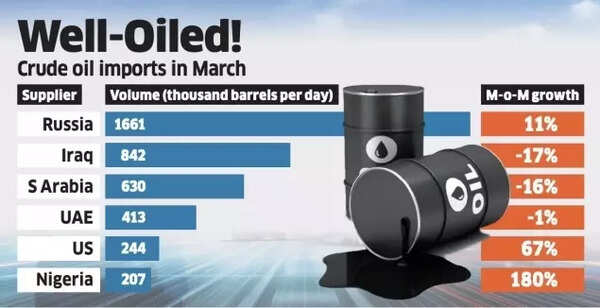Crude oil imports rise 67% from US, 11% from Russia; Trump tariff threats on Russia have little impact on India’s purchases
Indian refiners increased their US crude imports by 67% in March compared to February, at a time when US President Donald Trump is pushing for American energy exports. Notably, Russian imports grew by 11% despite January sanctions.
Trump has indicated potential complications for Russian oil trade unless Moscow reaches an agreement on the Ukraine conflict. He announced plans on Sunday to implement secondary duties ranging from 25-50% on Russian oil exports, alongside prohibiting buyers from US business operations.
“Trump’s threats to impose secondary tariffs on Russian oil buyers seem more like posturing in his ongoing negotiations with Russia,” said Mukesh Kumar Surana, CEO of Ratnagiri Refinery and Petrochemicals Ltd according to an ET report. “While there is unlikely to be any issue related to the availability of crude oil globally, refiners will need to be prepared with scenario analyses to ensure the economic sourcing of crude oil and uninterrupted operation of their complexes.”

Crude oil imports in March
Industry leaders who spoke to the financial daily expressed doubt about Trump taking substantial measures that would significantly reduce Russian oil’s presence in global markets, as such actions would increase fuel costs and conflict with his commitment to maintain affordable energy prices for American consumers.
India’s US crude imports reached 244,000 barrels per day (bpd) in March, increasing from 146,000 bpd in February, as reported by Vortexa, an energy cargo tracking firm. Russian crude imports increased by 11% to 1.66 million barrels per day (mbd) in March compared to the previous month.
Also Read | Elon Musk is world’s richest person on Hurun Rich List with $420 billion net worth – it’s the ‘Trump Effect’ at work?
This increase occurred despite broader predictions and initial vessel loading patterns, as Russia and traders discovered methods to bypass US sanctions for delivering shipments to Indian ports. The US implemented sanctions on two Russian producers and approximately 180 vessels involved in Russian oil transportation on January 10.
“More suppliers, especially those with tankers loaded with Russian oil, would have been in a hurry to offload their inventories due to rising uncertainties, giving Indian importers economic choices, which led to increased imports from Russia in March,” said Surana.
Supplies from Iraq and Saudi Arabia, India’s second and third-largest crude providers, declined significantly by 16-17% in March compared to February. Saudi Arabia increased its official selling price for March, anticipating higher demand from Indian purchasers following the sanctions.
Although Indian refiners initially considered obtaining additional supplies from Middle Eastern providers to compensate for a potential Russian reduction, they ultimately acquired more from the US and Nigeria whilst reducing imports of less cost-effective Saudi and Iraqi crude. Nigerian imports increased substantially to 207,000 bpd in March from 74,000 in February.
“Recently, sweet crude grades were economically attractive given their shrinking differential with sour grades, which predominantly come from the Middle East,” said Surana.





